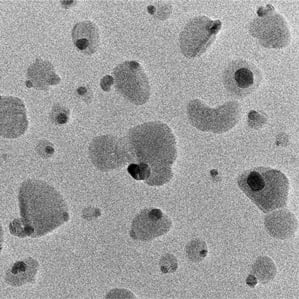A New Use for Coal: Glowing Nanodots
Coal can be turned into large volumes of glowing quantum dots, according to Rice University researchers.

The new method could represent a very cheap way to produce fluorescent carbon nanoparticles that could be useful in biomedicine, and especially in the imaging of living human cells and tissues, says James Tour, a chemistry professor at Rice. Tour, who led the research, says early tests suggest that the particles are nontoxic, and says his group is working on developing the particles into fluorescent probes and drug-delivery vehicles.
The researchers used sound waves to agitate three types of coal—bituminous, anthracite, and coke—each treated with acid. They then heated the samples for 24 hours. The resulting particles, which range in size from two to 40 nanometers, were made of several layers of graphene oxide, an atom-thick carbon compound with a highly ordered structure. The size of the particles made from each type of coal was distinct, and each size emitted a different color of fluorescence.
Tour and his colleagues say there is enough evidence to call the carbon particles quantum dots. Quantum dots are nanoparticles in which electrons are confined to a space smaller than their wavelength, a phenomenon which gives rise to fluorescence; different-sized dots glow different colors when excited by a light source. Tour acknowledges that future research might reveal the particles to be fluorescent due to factors other than this phenomenon, but he says that wouldn’t change the potential technological applications.
Graphene quantum dots have been made before, including from graphite and, more recently, from carbon fibers. But these sources are more expensive than coal and yield much lower volumes, says Tour.
Quantum dots made of inorganic semiconductors are beginning to appear in televisions and tablets as a means of generating richer colors (see “Quantum Dots Get Commercial Debut in More Colorful Sony TVs”).
Quantum dots are also useful for biological imaging (see “Quantum Dot Com”). They can be used to observe molecular-scale structures and events within cells and tissues, and tend to be brighter and maintain their fluorescence much longer than conventional fluorescent dyes, which often only emit light for a few seconds. Further, since the color of light emitted can be precisely tuned by adjusting the size of the dot, multiple colors can be used to image different biomolecules simultaneously, using the same light source. But while quantum dots have been used fairly extensively in animal research models, the most common ones contain toxic metals, and haven’t been tested in humans. Tour’s dots, which he says are nontoxic, could potentially be used in humans.
There is a strong desire within the research community to test quantum dots in humans, says Shimon Weiss, a professor of chemistry and biochemistry at UCLA, since in principle they could be used for precise imaging, diagnostics, and treatment monitoring. An efficient, nontoxic probe would be a boon for the field. But it’s too early to tell if Tour’s dots represent such a candidate, says Weiss.
Keep Reading
Most Popular
Large language models can do jaw-dropping things. But nobody knows exactly why.
And that's a problem. Figuring it out is one of the biggest scientific puzzles of our time and a crucial step towards controlling more powerful future models.
The problem with plug-in hybrids? Their drivers.
Plug-in hybrids are often sold as a transition to EVs, but new data from Europe shows we’re still underestimating the emissions they produce.
Google DeepMind’s new generative model makes Super Mario–like games from scratch
Genie learns how to control games by watching hours and hours of video. It could help train next-gen robots too.
How scientists traced a mysterious covid case back to six toilets
When wastewater surveillance turns into a hunt for a single infected individual, the ethics get tricky.
Stay connected
Get the latest updates from
MIT Technology Review
Discover special offers, top stories, upcoming events, and more.